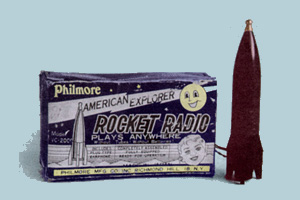
I
have always been fascinated with radio. It began over 50 years ago, when
I was about two years old. My father put in front of my face the carbon
microphone that was part of our Sears Silvertone family radio console and
asked me to say something. Being much more contextual then than I am now,
I said "There's a radio station in there." I knew it then as truth. There
always was.
You see, Dad's voice
came out of that huge veneer box every day. It was to my young mind as
if my father magically had become a miniature announcer in a miniature
radio station that was part of the innards of that console. Of course,
as I grew older, I came to understand just how all that magic worked.

When Sputnik began circling my world on that October day in 1957, I heard
the news on an old Zenith five-tuber that my parents eventually moved from
the kitchen to my bedroom. Around 1957, Dad took me downtown to Custom
Electronics, the local radio store, and plunked down $71.75 for a
Hallicrafters S38E short wave receiver. The entire world opened up for
me with that radio. I could hear voices from other countries, voices in
foreign languages, music, philosophies, religions and the extended thought
of a global community.
In the end, I came to speak Spanish with a Cuban accent, played tenor and
alto sax with local jazz groups on "the black side of town," got two free
copies of
Chairman Mao's Thought and, by the beginning of 1966,

forgot all about that magical radio station that hid inside the box, all
its politics and music and Mexican beer commercials replaced by hippie
hedonism.
By 1968 I was in
the US Navy, sent off to Norfolk, Virginia, to learn how radio teletype
and cryptographic equipment worked in the defense of all the things that
radio had taught me . . . or made me question.
In Puerto Rico, I got interested in amateur radio again. I built a Heathkit
receiver and transmitter and got my first ham radio licence. I talked to
people in Sweden, Russia, France and England. By the time I got orders
sending me to the USS Saratoga, I was hooked, deepfried & wrapped in
radio.

When I got out of
the Navy in 1972, I eventually ended up on the production line of the R.L.
Drake Company, testing, repairing and turning out 20 high-performance
amateur radio transceivers a day. That led me to the job I have now, working
in the educational media department of the same university from which I
went to join the navy.
There's a radio station in there . . .
which leads to the next page.




 years ago. It was originally a carbon button mic, probably for Sears made by Electrovoice.
years ago. It was originally a carbon button mic, probably for Sears made by Electrovoice.